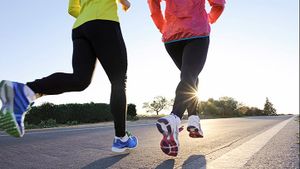Premenstrual Syndrome: Difference between revisions
No edit summary |
No edit summary |
||
| Line 94: | Line 94: | ||
==== Physical Therapy Management ==== | ==== Physical Therapy Management ==== | ||
[[File:Exercise photo.jpg|thumb]] | |||
Exercises is the first line treatment for PMS, repeated muscle contraction during physical exercises prevent accumulation of PG and other substances so reduces back and abdominal pain, exercise has a positive effect on emotional conditions and to manage stress. | |||
Aerobic exercises for example increase RBC, decrease the levels of progesterone and estradiol, resulting in improvement of concentration, fatigue, and majority of PMS symptoms<ref>Dehnavi ZM, Jafarnejad F, Goghary SS. [https://bmcwomenshealth.biomedcentral.com/articles/10.1186/s12905-018-0565-5 The effect of 8 weeks aerobic exercise on severity of physical symptoms of premenstrual syndrome]: a clinical trial study. BMC women's health. 2018 Dec;18(1):1-7.</ref>. | |||
== Differential Diagnosis<br> == | == Differential Diagnosis<br> == | ||
Revision as of 02:43, 17 January 2022
Definition[edit | edit source]
Premenstrual Syndrome (PMS) is a combination of physical, psychological/emotional, or behavioral symptoms that start one or two weeks before the beginning of menstruation after the ovulation period. The severity range from mild to severe that may hinder their work and ADL activities. And they start to resolve with the beginning of the menstruation as the levels of the hormones start to return to their levels. PMS symptoms may change throughout your life in severity and complain, depression, stress, or history with postpartum depression are all contributing factors that may worsen your symptoms. PMS may get worse when women approach menopause especially at the end of their 30s or 40s and stop after menopause. If the woman has a history of seizure disorders, migraines, asthma, or allergies they will get worse during the PMS period. PMS represents about 75% of women of reproductive age, and severe symptoms find in about 5–8% of women.
Premenstrual dysphoric disorder (PMDD) is similar to PMS but characterized by sever irritability, depression, and anxiety and affects 3–8% of menstruating women[1].
Cause of Premenstrual Syndrome[edit | edit source]
The definite cause for PMS is still not fully understood and may be multifactorial causes:
- The most suggested is fluctuation in hormones levels (ovarian hormones) during the menstruation cycle which in turn affects central neurotransmitters. There is evidence suggesting that a low level of circulating serotonin and enhanced progesterone sensitivity can explain PMS in some cases.
- Prostaglandin (PG) deficiency, PG has a role in forming prostaglandin precursors from linoleic acid[2].
- Genetic factors and depression may worsen the symptoms of PMS[3].
- The role of minerals and vitamins in etiology is still debatable and their role in treatment also[2].
Clinical Presentation[edit | edit source]
Physical symptoms:
- Abdominal bloating and cramping.
- Fatigue.
- Constipation
- Headache.
- Breast tenderness.
- Constipation or diarrhea.
- Change in appetite.
- Disturbance with sleeping ( sleeping more than usual or sleeping too little)
- Skin problems, acne.
- Gastrointestinal symptoms.
muscles and joint pain
Emotional symptoms:
- Depression.
- Anxiety.
- Anger.
- Oversensitivity.
- Mood swing.
- Crying spells
- Less interest in sex.
- Insomnia.
- Poor concentration.
Diagnostic Procedures[edit | edit source]
There is no definitive diagnostic test and the diagnosis of PMS depends on reporting to the symptoms for at least two or three months.
When rating the symptoms they must be present five days before the start of menstruation (during the luteal phase) for at least two cycles as recommended by RCOG, and these symptoms resolve within 4 days after the start of a period, these symptoms should:
- Negatively affect her ADLs and may cause some impairments.
- Exclude other diagnoses that may cause similar symptoms.
- One of the four physical symptoms (abdominal bloating, headache, breast tenderness, and swelling of extremities), and one of the following (angry spells, depression, anxiety, confusion, irritability and social withdrawal) according to American College of Obstetricians and Gynecologists[2].
She can use daily reporting severity scale to record her symptoms daily.
Outcome Measures[edit | edit source]
Premenstrual Tension Syndrome Observer (PMTS-O)
Premenstrual Tension Syndrome Self-Rating (PMTS-SR).
Management / Interventions
[edit | edit source]
Medical management[edit | edit source]
Selective serotonin reuptake inhibitors (SSRIs) is the first pharmacological line recommended by RCOG guidelines for sever PMS, it was effective to treat moderate and sever symptoms of PMS, and should be discontinued gradually to avoid withdrawal symptoms if given on a continuous.
Combined oral contraceptive pills (COC)
GnRH analogues is effective in treatment of PMDD and could not be used for a long period it may cause genital atrophy and bone loss because of estrogen deficiency. Used when SSRI and COC failed to treat symptoms.
Diuretics (water pills) such as Spironolactone.
Vitex, is safe to use and it was superior to placebo, however, further research about Vertix is still needed[2].
Cognitive Behavioral Therapy[edit | edit source]
RCOG guidelines stated that "When treating women with severe PMS, CBT should be considered routinely as a treatment
option" level of evidence A. CBT help women to control and manage their symptoms can be useful for some women, and it's effect will maintain for a period of time[6].
Physical Therapy Management[edit | edit source]
Exercises is the first line treatment for PMS, repeated muscle contraction during physical exercises prevent accumulation of PG and other substances so reduces back and abdominal pain, exercise has a positive effect on emotional conditions and to manage stress.
Aerobic exercises for example increase RBC, decrease the levels of progesterone and estradiol, resulting in improvement of concentration, fatigue, and majority of PMS symptoms[7].
Differential Diagnosis
[edit | edit source]
Premenopause.
Resources[edit | edit source]
Management of Premenstrual Syndrome, RCOG Guidelines
References[edit | edit source]
- ↑ Gao M, Gao D, Sun H, Cheng X, An L, Qiao M. Trends in Research Related to Premenstrual Syndrome and Premenstrual Dysphoric Disorder From 1945 to 2018: A Bibliometric Analysis. Frontiers in Public Health. 2021 Apr 21;9:380.
- ↑ 2.0 2.1 2.2 2.3 Dilbaz B, Aksan A. Premenstrual syndrome, a common but underrated entity: review of the clinical literature. Journal of the Turkish German Gynecological Association. 2021 Jun;22(2):139.
- ↑ 3.0 3.1 Dickerson LM, Mazyck PJ, Hunter MH. Premenstrual syndrome. American family physician. 2003 Apr 15;67(8):1743-52.
- ↑ Reactions. What Causes PMS? . Available from: http://www.youtube.com/watch?v=W5BvYvyfarw[last accessed 14/1/2022]
- ↑ Steiner M, Streiner DL, Steinberg S, Stewart D, Carter D, Berger C, Reid R, Grover D. The measurement of premenstrual mood symptoms. Journal of affective disorders. 1999 Jun 1;53(3):269-73.
- ↑ Hofmeister S, Bodden S. Premenstrual syndrome and premenstrual dysphoric disorder. American family physician. 2016 Aug 1;94(3):236-40.
- ↑ Dehnavi ZM, Jafarnejad F, Goghary SS. The effect of 8 weeks aerobic exercise on severity of physical symptoms of premenstrual syndrome: a clinical trial study. BMC women's health. 2018 Dec;18(1):1-7.









